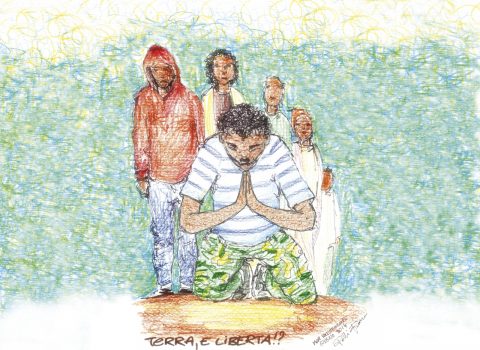Conclusions: tomatoes at 99 cents
The conclusions of the end of the HEADING "The European Migration Government" curated by Osvaldo Costantini, associate researcher at the Center for Religious Sciences of FBK. Co-author of the article: Daniela Galiè
The stories contained in this section describe a range of phenomena concerning the law of the border, the geopolitical relations between the States, the economic rules that structure the relationship between North and South, up to the specific cultural elaborations at the base of the categories with which they are interpreted and classify migration phenomena. Most of these aspects would need a reflection that goes beyond the will, sometimes the skills, and above all the space available to the writer. However, the aspects defined by the hotspot approach and by the more specific European and global border doctrine require a framework able to create an analytical connection with the broader social and political issues of our times. This is not a posture that is at all costs “critical” against a Western power, always seen as oppressive, but the result of the inputs provided by our interlocutors: migrants constantly ask for an explanation, more or less directly, often through their actions, of a global system where goods, capital and some groups of people can cross borders at will, while a large part of humanity not only does not have access to the same freedom of movement, but is constantly criminalized if they try to do so. In more complex terms: their actions, their will to desire a better future, their obstinacy to emerge from the areas arranged for them by the current global social order express the conflict between the will and the need for movement and the “European” concept of border and freedom of movement. In fact, the practices of resistance to the regulations on migration, have suffered a setback, where the control practices, being constantly defined and refined, have determined the physiognomy of the border and its surrounding territory. In fact, the profound change noted by Giuseppe Campesi (Polizia di frontiera. Frontex e lo spazio confinario europeo, Derive & Approdi, 2015), is not beyond cultual analysis: the military defense of the border, a time useful to defend a space of internal sovereignty against the attack of other military forces, today is more and more an instrument of defense from the outside against non-military phenomena, such as migrations. In the same way, the hierarchy of the value of human lives belongs to the analysis of cultural logics, based on a simple construction of the symbolic border between “us” and “them”: the line to cross, Didier Fassin wrote, to ensure that one’s life from worth sacrifying becomes sacred, is more and more like a macabre obstacle course. If until the summer of 2017 European aid materialized in a “border show” limited to the practice of “saving lives”, through NGO and Italian Navy ships, which guarded the central Mediterranean in the so-called Search and Rescue operations, after the agreements between Italy and Libya in the summer of 2017, the material and symbolic levels change radically. In the first phase, the humanitarian deployed its ambiguous power to “save lives”, and at the same time place people in confined and supervised spaces. With the Accords, the “saving lives” concept is questioned and criminalized: the NGOs are accused of collusion with “the traffickers” or “the smugglers”, with important posts of the judiciary embarking in public declarations without even having opened official proceedings; a mainstream rhetoric that makes it acceptable for asylum seekers to be caught at sea by the Libyan coast guard and taken back to a country where slave trade has been restored, where people are subjected to all kinds of torture and exploitation, where even institutional prisons are known for their violence and brutality. The basis for this acceptability cannot be read as a strong construction of the symbolic border between “us” and “them”, where “their” lives are worth less than ours: drowned in the sea, exploited, beaten, killed… is of little importance to the eyes of a public opinion that makes the supremacy of the white race an implicit factor of distinction between what is legitimate and acceptable and what is not. With a constant shift of the acceptably stick a bit higher… indeed, a little lower.
The will to govern the migratory phenomenon according to the laws of utility and, ultimately, of the labor market, is also expressed and reflected in the way the migrants are managed on European territory. In this area, we must first analyze the historical-political constructions of the categories with which human beings in excess are classed, in order to put in place a repressive government based on utility (we will elaborate on this shortly): non-EU, illegal and undocumented migrants and today the distinction between “economic migrants” and “asylum seekers”, which on the phenomenological level, as now widely explored by the social sciences, finds no justification whatsoever. The bi-categorical distinction expresses only a blind desire to carry out a precise governance of the bodies: upon entry into Europe a certain set of practices and social players deploy a judgment activity, to the limits of what Foucault defined as the “administrative grotesque”, reserving to individual officials a power of life or death on the incoming subjects: acceptable or to be sent back, becasue he/she is an “economic migrant”. In the same way, however, those who are accepted must undergo a rigid partitioning of access to mobility: relegated to the reception centers of the southern countries, their space-time dimension is decidedly directed to what is different. Any self-determination attempt, as we have seen in the cases of deportations, and crossing the borders lead to contrast actions at the limit and beyond the European legal system itself.
In fact, what we observe along the route that goes from the Hotspot structure of Taranto, and in general from the 4 southern locations, used to receive and identify migrants in Italy (Pozzallo, Lampedusa and Trapani) to the French border, is one part of a difficult path that starts from the external borders of the Schengen area and continues in Europe in a climate of violence different only in degree but not in nature.
In full force with the plan, mentioned several times, of “lightening of internal borders” and of containment and inhibition of so-called “secondary displacements”, numerous institutional attempts to control the transit from border towns have taken shape in recent years. Ventimiglia, for example, as a transit city par excellence, still represents its preferential field of application, despite the media attention, coinciding with the provisions of forced displacement and urban and border security, has gradually decreased.
In the phases in which the Ligurian town showed itself as the main container of the government rejection mechanism of migrants from France and of temporary staging of individuals in transit, evictions, raids, arrests and “persuasion” operations were carried out to remove migrants from the residential and central areas of the town.
Ventimiglia has represented a fundamental point of observation to understand the change in the government of migration in Europe, as well as of the national policies for the management of the phenomenon of transiting individuals. In a historical phase that sees new political scenarios open and new fronts of government, on a national as well as international scale, the theme of the border will be called into question once again, to re-propose itself with new formulas, as a containment strategy, consolidating an order of “differentiating” discourse which wants as a main result the affirmation of a rhetoric of selection and of rapid sorting.
We have observed, over time, how the management of migratory flows does not follow a linear path or a static phenomenological representation, such as the construction of walls, the deployment of police forces and the rejection procedures. The obsession with migration has very often to do with the need to select flows according to the needs (mostly political, economic and social) of the destination contexts. The selection activity follows multiple trajectories, and is produced thanks to a complex set of legal and rhetorical formulas.
The restriction of mobility, the denial of a decent reception system and the process of differentiation underway at access points to the European area are manifestations of a governmental laboratory, in the same way that the attempts to neutralize politics and criminalize forms of solidarity are the result immediate establishment of securitized government agendas.
In addition to this, we shhouls take into account the method of outsourcing and the extension of physical frontiers, a salient point of the agreements entered into by transit and destination countries. They have, in fact, determined the creation of a system of differentiation of the world population in accessing geographical mobility, in order to filter the incoming labor force.
The migrants that are “blocked” in Italy, in fact, represent a pool of labor for northern Europe, self- and hetero-proclaimed territory of integration and reception. In our country, with precarious status and uncertainty about obtaining the documents, migrants fall, as we have seen in the last two stories of this column, victims of a system that produces vulnerability: agricultural labor, construction or personal care (in the best scenarios) as well as prostitution engulf this humanity that cannot claim rights. They fit into those segments of the system too often called “marginal”, but which in our view represent the center of the current economic system based on overproduction and exploitation. Their social and legal marginality is what characterizes their “economic centrality”: to understand this, one just nee to step into a chain supermarket and watch the tomatoes on special discount at 99 cents a kilo.
Daniela Galiè is a member of the Esc-Infomigrante project of the Esc-Inforights association.
The “European Migration Government” column is organized by OSVALDO COSTANTINI, an associate researcher at the Center for Religious Sciences of the Bruno Kessler Foundation, which is involved in the lifestyle and conflicts research lines. Within this interest moves between scientific publications and public press releases, especially in relation to those aspects of the #migration more closely related to the imaginations, the desires, and the related frustrations and disillusionments that move the actions of these new “damned of the earth”.
PREVIOUS ARTICLES:
From the hotspot to the street. The story of two women from Comoros
Stories of (induced) marginality
Ventimiglia between official reception and informal ways
God’s will for a better life
The Maritime Alps
Hotspot hemisphere
How Is Europe Governing Migration

